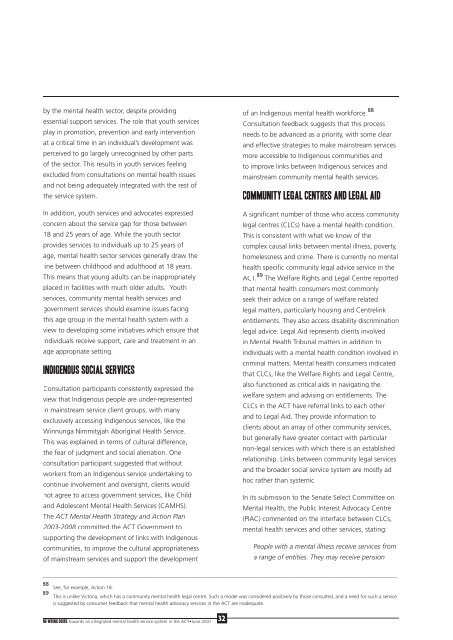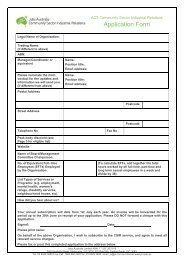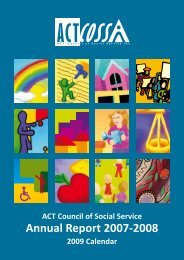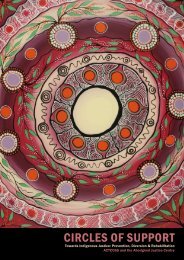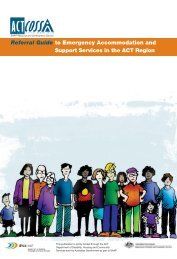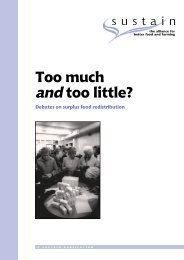actcoss text final.indd - ACT Council of Social Service
actcoss text final.indd - ACT Council of Social Service
actcoss text final.indd - ACT Council of Social Service
You also want an ePaper? Increase the reach of your titles
YUMPU automatically turns print PDFs into web optimized ePapers that Google loves.
y the mental health sector, despite providing<br />
essential support services. The role that youth services<br />
play in promotion, prevention and early intervention<br />
at a critical time in an individual’s development was<br />
perceived to go largely unrecognised by other parts<br />
<strong>of</strong> the sector. This results in youth services feeling<br />
excluded from consultations on mental health issues<br />
and not being adequately integrated with the rest <strong>of</strong><br />
the service system.<br />
In addition, youth services and advocates expressed<br />
concern about the service gap for those between<br />
18 and 25 years <strong>of</strong> age. While the youth sector<br />
provides services to individuals up to 25 years <strong>of</strong><br />
age, mental health sector services generally draw the<br />
line between childhood and adulthood at 18 years.<br />
This means that young adults can be inappropriately<br />
placed in facilities with much older adults. Youth<br />
services, community mental health services and<br />
government services should examine issues facing<br />
this age group in the mental health system with a<br />
view to developing some initiatives which ensure that<br />
individuals receive support, care and treatment in an<br />
age appropriate setting.<br />
INDIGENOUS SOCIAL SERVICES<br />
Consultation participants consistently expressed the<br />
view that Indigenous people are under-represented<br />
in mainstream service client groups, with many<br />
exclusively accessing Indigenous services, like the<br />
Winnunga Nimmityjah Aboriginal Health <strong>Service</strong>.<br />
This was explained in terms <strong>of</strong> cultural difference,<br />
the fear <strong>of</strong> judgment and social alienation. One<br />
consultation participant suggested that without<br />
workers from an Indigenous service undertaking to<br />
continue involvement and oversight, clients would<br />
not agree to access government services, like Child<br />
and Adolescent Mental Health <strong>Service</strong>s (CAMHS).<br />
The <strong>ACT</strong> Mental Health Strategy and Action Plan<br />
2003-2008 committed the <strong>ACT</strong> Government to<br />
supporting the development <strong>of</strong> links with Indigenous<br />
communities, to improve the cultural appropriateness<br />
<strong>of</strong> mainstream services and support the development<br />
<strong>of</strong> an Indigenous mental health workforce. 88<br />
Consultation feedback suggests that this process<br />
needs to be advanced as a priority, with some clear<br />
and effective strategies to make mainstream services<br />
more accessible to Indigenous communities and<br />
to improve links between Indigenous services and<br />
mainstream community mental health services.<br />
COMMUNITY LEGAL CENTRES AND LEGAL AID<br />
A significant number <strong>of</strong> those who access community<br />
legal centres (CLCs) have a mental health condition.<br />
This is consistent with what we know <strong>of</strong> the<br />
complex causal links between mental illness, poverty,<br />
homelessness and crime. There is currently no mental<br />
health specific community legal advice service in the<br />
<strong>ACT</strong>. 89 The Welfare Rights and Legal Centre reported<br />
that mental health consumers most commonly<br />
seek their advice on a range <strong>of</strong> welfare related<br />
legal matters, particularly housing and Centrelink<br />
entitlements. They also access disability discrimination<br />
legal advice. Legal Aid represents clients involved<br />
in Mental Health Tribunal matters in addition to<br />
individuals with a mental health condition involved in<br />
criminal matters. Mental health consumers indicated<br />
that CLCs, like the Welfare Rights and Legal Centre,<br />
also functioned as critical aids in navigating the<br />
welfare system and advising on entitlements. The<br />
CLCs in the <strong>ACT</strong> have referral links to each other<br />
and to Legal Aid. They provide information to<br />
clients about an array <strong>of</strong> other community services,<br />
but generally have greater contact with particular<br />
non-legal services with which there is an established<br />
relationship. Links between community legal services<br />
and the broader social service system are mostly ad<br />
hoc rather than systemic.<br />
In its submission to the Senate Select Committee on<br />
Mental Health, the Public Interest Advocacy Centre<br />
(PIAC) commented on the interface between CLCs,<br />
mental health services and other services, stating:<br />
People with a mental illness receive services from<br />
a range <strong>of</strong> entities. They may receive pension<br />
___________________________________________________________________________________________________________________________<br />
88 See, for example, Action 18.<br />
89 This is unlike Victoria, which has a community mental health legal centre. Such a model was considered positively by those consulted, and a need for such a service<br />
is suggested by consumer feedback that mental health advocacy services in the <strong>ACT</strong> are inadequate.<br />
NO WRONG DOORS Towards an integrated mental health service system in the <strong>ACT</strong>•June 2007<br />
32


